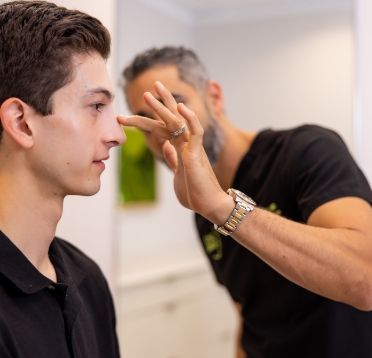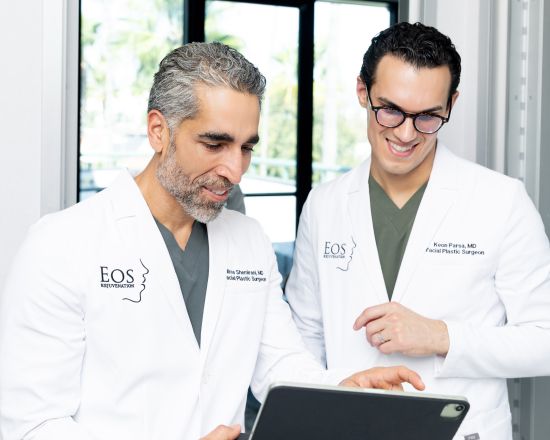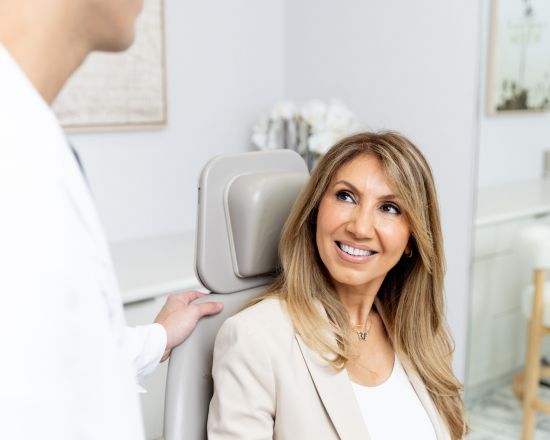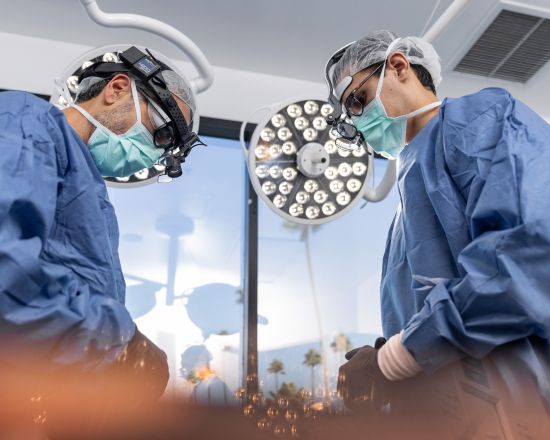Revision Rhinoplasty Beverly Hills
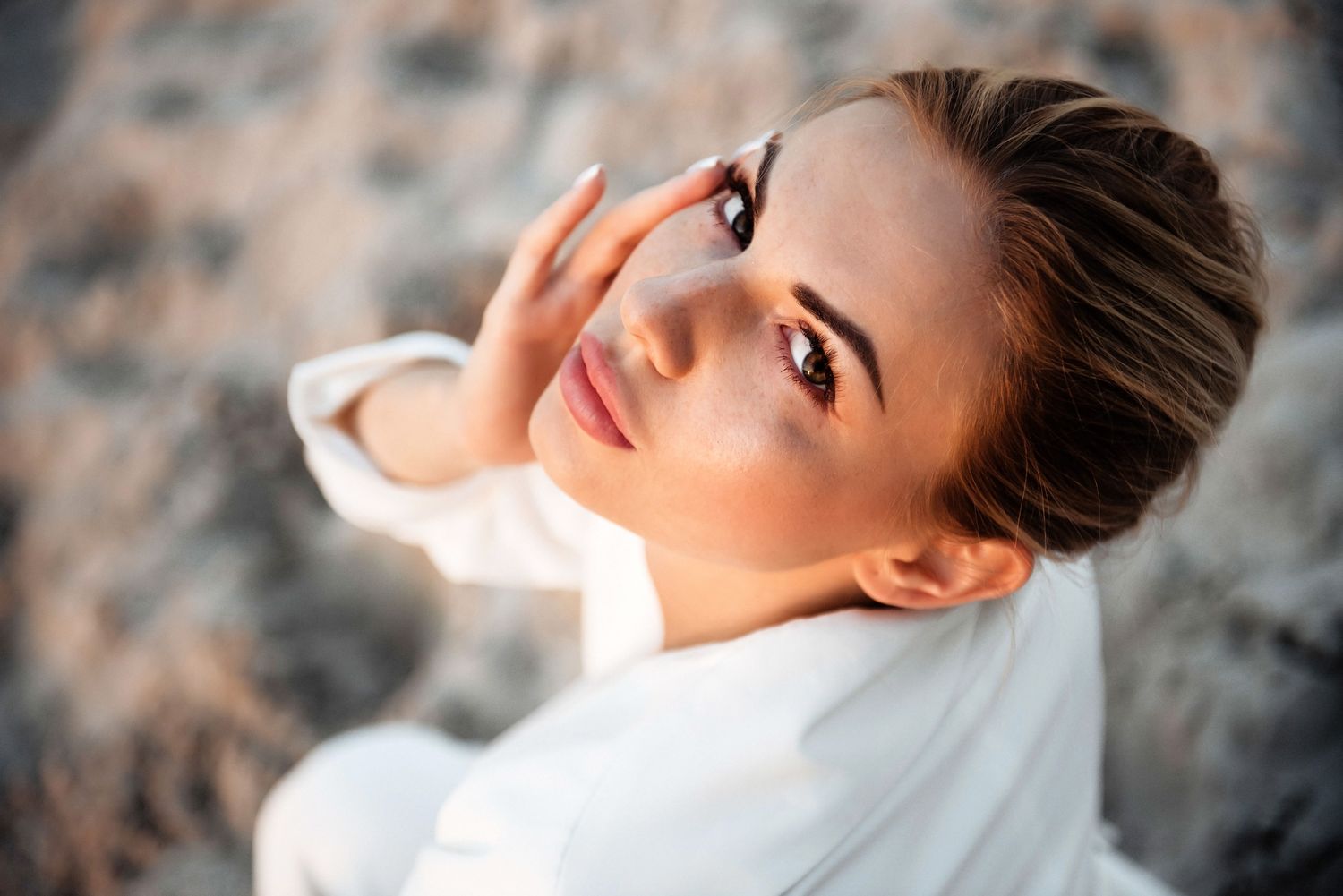

A botched nose job can be an extremely traumatizing, heartbreaking, and stressful experience. Imagine preparing for countless hours, spending thousands, and enduring a surgical procedure only to be crushed emotionally after the bandage reveal. Eos Rejuvenation in Beverly Hills sympathizes with these victims and has helped countless patients reclaim the dream nose they imagined before an unsuccessful surgery.
Rhinoplasty revision surgery allows patients to reclaim the form and function of their nose that they originally desired in the first place. Dr. Nima and our surgeons specialize in rhinoplasty revisions and has accrued hundreds of verified 5-star RealSelf reviews from patients. See for yourself what people are saying about Eos Rejuvenation.
1 of 21
Patients may opt for revision rhinoplasty because they are unhappy with the appearance of their nose, improper nose function, or a combination of both after an unsuccessful rhinoplasty procedure.
Aesthetically, patients are looking for exact results before committing to cosmetic surgery. Unfortunately, an inexperienced or uncertified surgeon may miss the mark completely, devastating a patient. Our surgeons commonly perform aesthetic revision rhinoplasty at Eos Rejuvenation, using state-of-the-art technology and techniques to delicately redesign, form, and heal your facial centerpiece into the dream nose you originally desired.
Functional revision rhinoplasty is necessary when an inexperienced surgeon cannot make a nose look good while optimizing nasal airway function. Functional issues include internal or external nasal valve collapse due to excessive scar tissue. This surgery rectifies and redesigns a nose for function by harvesting pre-existing cartilage to reinforce the nose, correct asymmetries, or otherwise alleviate imperfections.
We can also combine both functional and aesthetic techniques during this procedure to fix both problems.

Some of the issues targeted with aesthetic revision rhinoplasty include:
At Eos Rejuvenation, we want to make revision rhinoplasty as simple, painless, and successful as possible. In pursuit of this goal, we are happy to offer our patients treatment via the innovative Piezosurgery® method. This advanced technique involves cutting and moving bone via an ultrasonic scalpel, eliminating the need to break bones or cause undue facial trauma. The advantage of this technique is a more precise surgical result, as well as an expedited recovery.
Click to Watch Dr. Nima Explain Why People Get Revision Rhinoplasty

There are generally three categories of revision rhinoplasty: aesthetic (to improve appearance), functional (to improve breathing, decrease snoring, or otherwise alleviate nasal discomfort), or a combination of both. Each category involves a different approach.
Aesthetic revision rhinoplasty is the more common of the two. For some, an initial rhinoplasty left their nose too pinched or crooked, or a hump may not have been satisfactorily alleviated. In such instances, a revision will focus on building the nose back up. We will replace missing cartilage and give the nose more support.
With functional revision rhinoplasty, our focus is on ensuring that your nose works the way nature intended it to. As one might expect, there are a variety of reasons for problems with proper nasal functionality. Examples include a trauma suffered while healing or a previous surgery (especially reductive procedures performed far in the past), which failed to properly heal.
In these and other instances, during your procedure, cartilage – most likely harvested from inside your own nasal cavity, but sometimes from your ear or ribs – will be utilized to reinforce the nose, correct asymmetries, or otherwise alleviate imperfections.
The first step is an in-depth consultation. Here, we will discuss your specific cosmetic goals, answer questions, and explain procedural techniques. We will inspect and take photos of your nose, then use state-of-the-art imaging software to show you what your future nose will look like after the procedure. Lastly, we will review any medical paperwork or history you have related to one or more previous unsatisfactory rhinoplasties you’ve had. This allows us to develop an intimate understanding of your issues so we can give you the rhinoplasty results that you are looking for.

After determining your aesthetic goals, you will schedule a surgery date. Your Beverly Hills revision rhinoplasty procedure will occur at our accredited outpatient surgery center under general anesthesia.
Depending on your treatment plan, your surgeon will follow an open or closed rhinoplasty approach. An open rhinoplasty approach involves placing the incision across the columella (i.e., the bridge of tissue separating the nostrils at the bridge of the nose). In contrast, the incisions for a closed rhinoplasty approach are internal. Generally, we prefer an open rhinoplasty approach, allowing for better visualization and precision.
During revision rhinoplasty Beverly Hills plastic surgeons, Dr. Nima and Dr. Parsa use the utmost care and artistic skill to correct any issues following your initial rhinoplasty procedure, such as cosmetic or functionality problems. This revision may involve correcting nasal obstructions or delicately reshaping sections of the nose along the nasal bridge, tip, and nostrils.
In some cases, if your previous rhinoplasty overcorrected your nose, your surgeon may need to procure and add back tissue to achieve optimal results. If necessary, this tissue may come from your septum, ear, rib, or an external source.
Once your surgeon has completed your revision rhinoplasty, the incisions will be closed. Our surgical team will move you to our modern, comfortable recovery room until the anesthesia wears off.
You should allow for 7-14 days to heal before returning to work and daily life. During this time, you may experience some nasal swelling, mild bruising, nasal discharge, stiffness, and difficulty breathing.
We have eliminated the uncomfortable nasal packing that is typically used and opt for a cast that rests on the bridge of the nose during the first week of recovery. It may take up to a year to fully heal as the nose settles into its new position and all swelling subsides.
The team at Eos Rejuvenation in Beverly Hills is devoted to ensuring that our patients feel reassured and comfortable every step of the way. As this will be the second time recovering from a rhinoplasty procedure, we want to take special consideration to ensure proper recovery. In a post-op visit, we will explain in-depth the steps necessary to heal and cover any specific questions you have.
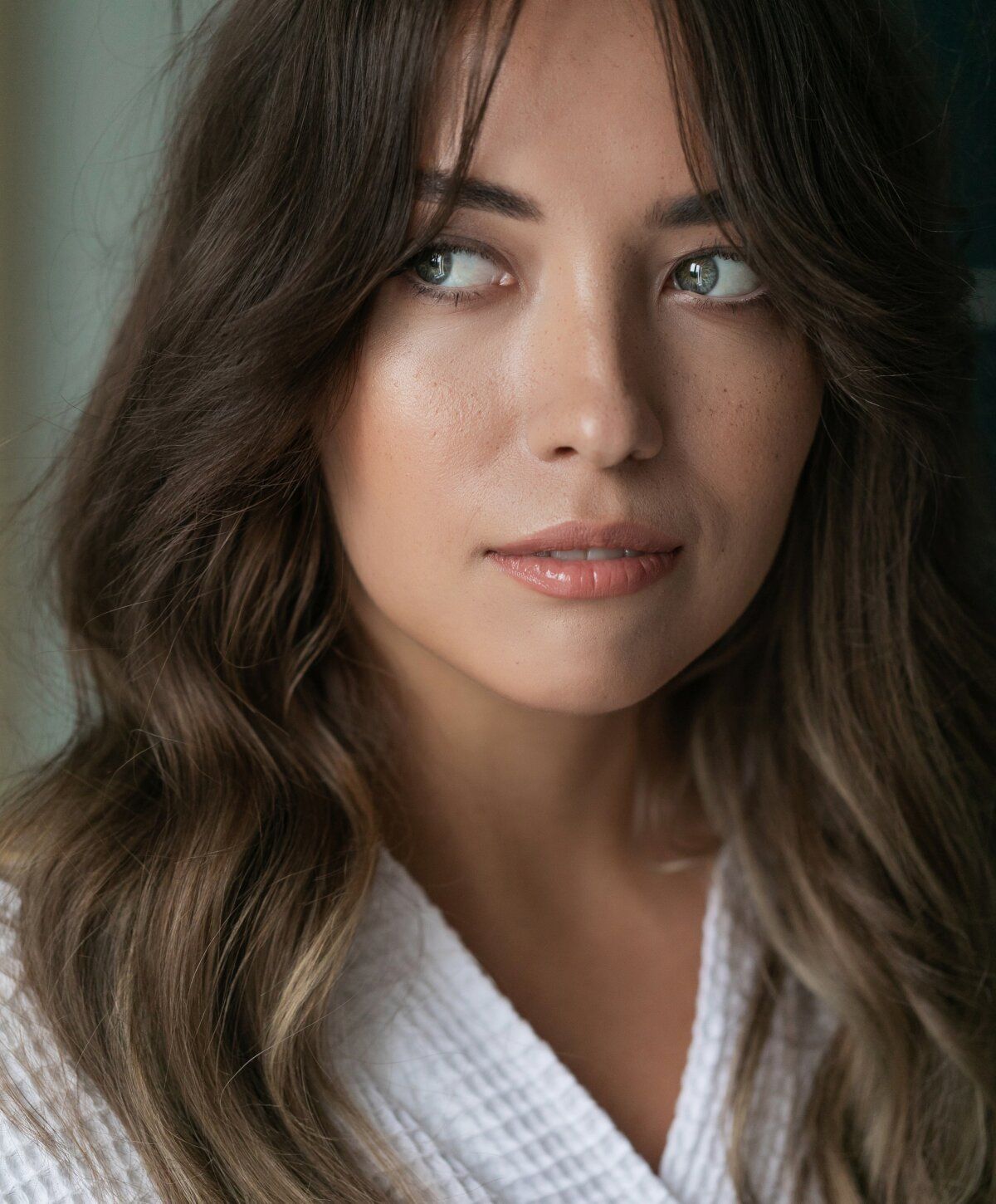
As post-operative swelling subsides and the nasal tissues settle into position, your new profile comes into focus. You will see the improvements within the first few weeks, while it may take up to a year to enjoy your most refined results. The wait is worthwhile, as revision rhinoplasty can significantly enhance your facial harmony, boost your confidence, and improve your overall quality of life.
By addressing imperfections from a previous rhinoplasty, you can achieve a nose that aligns with your aesthetic goals, complements your facial features, and allows you to breathe with ease.
We strive for excellence in reconstructive and plastic surgery services for our patients. We use a highly personalized approach to help revision rhinoplasty patients reclaim their dream nose, leaving the memory of their first or second botched rhinoplasty in the past. Ready to take the next step? Contact us today!
Many plastic surgeons recommend that a patient’s nose be fully healed before revision rhinoplasty, though every case is different depending on the patient’s reason for the revision. Examples of common problems that may require revision rhinoplasty include excessive scarring, nasal airway obstruction, and worsened asymmetry.
Factors that may be considered when deciding how soon patients can undergo revision rhinoplasty include the amount of scar tissue present, number of previous nasal surgeries, and nasal framework. Patients who wish to have revision rhinoplasty can schedule a consultation with Eos Rejuvenation in Beverly Hills to receive an evaluation and determine when they qualify to have revision surgery.
Revision rhinoplasty can correct problems with worsened asymmetry and uneven nostrils that may have resulted from a past rhinoplasty procedure. However, it is normal for some rhinoplasty patients in Beverly Hills to have uneven nostrils immediately after surgery due to swelling, nasal splints, and the formation of scar tissue.
Rhinoplasty patients may want to wait at least six months to see if symmetry is restored to their nostrils before deciding to have revision rhinoplasty. After the six-month mark, those who have uneven nostrils due to a past rhinoplasty procedure can meet with a plastic surgeon to discuss the possibility of revision surgery.
In some instances, rhinoplasty can result in a far smaller nose than what the patient desired. At our practice in Beverly Hills, revision rhinoplasty can make the nose larger using grafts from the patient’s body. A plastic surgeon may place spreader grafts in the bridge of the nose to widen the nose or enlarge the nasal tip.
Though making a nose larger is less common with rhinoplasty, this can be done to correct a failed rhinoplasty surgery. Those Beverly Hills patients who want to make their noses larger can consult with an experienced plastic surgeon to discuss whether revision rhinoplasty can be safely performed without causing breathing problems or other unwanted side effects.
Yes, revision rhinoplasty can remove scar tissue that may have resulted from a previous rhinoplasty procedure. Excessive amounts of scar tissue can sometimes form between the cartilage and skin to affect the final results of the failed rhinoplasty surgery. Scar tissue can be successfully removed by an experienced, plastic surgeon who can safely perform the procedure without affecting blood supply or worsening the appearance of the nose.
Rhinoplasty patients can reduce their risk of developing excess scar tissue and requiring revision rhinoplasty by wearing nasal tape throughout the healing phase. Patients can also adhere closely to their plastic surgeon’s post-op instructions to avoid developing excess scar tissue.
Weakened cartilage and nasal structure can sometimes shift or collapse after rhinoplasty to change the appearance of the nose—often resulting in the need for revision rhinoplasty. A shift or collapse of cartilage may also happen if too much bone or tissue was removed from the nose during the failed rhinoplasty. These changes occur most frequently after swelling has gone down or after the nose has fully healed following surgery.
Revision rhinoplasty can correct cartilage that has shifted or collapsed and may involve the use of grafts to restructure the nose. Undergoing revision rhinoplasty with an experienced facial plastic surgeon in Beverly Hills can reduce the risk for future instances of shifting or collapsing cartilage.
Patients seek revision rhinoplasty when their initial procedure goes badly, or they are not fully satisfied with the results. There is no set limit on how many revision rhinoplasty procedures you can have, but the more times you have a revision rhinoplasty, the more challenging the procedure is for your surgeon. Revision rhinoplasty tends to be more complex than the initial surgery, and each additional revision compounds that complexity.
Sometimes, patients seek a revision rhinoplasty to correct a minor problem or “touch up” their rhinoplasty results. In these situations, it is reasonable to return to your original surgeon. However, if you are unhappy with your rhinoplasty results and believe the surgeon’s level of skill or experience played a part in that, it is only logical to seek a second opinion from a facial plastic surgeon, preferably someone with great experience performing rhinoplasty procedures.
Revision rhinoplasty is more complex than an initial rhinoplasty. Because of this, the surgery itself tends to be more time-consuming. Additionally, you can expect a longer recovery time for your revision rhinoplasty. This is because tissues that have already been altered and formed scar tissue will need to heal once again. This healing process takes a little while longer than the initial healing process.
Over 85% of rhinoplasty patients are quite happy with their initial results, and research shows that only a small percentage of patients require any kind of revision. Revision rhinoplasties are more complex than the initial procedure, yet many patients only need minor corrections or touch-ups. As such, most patients who have a revision rhinoplasty performed end up being very happy with their results. The key to having a successful surgery is looking for a surgeon who specializes in rhinoplasty and has a notable history of providing successful results.
